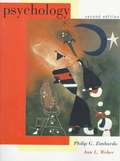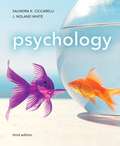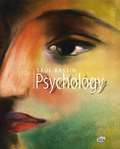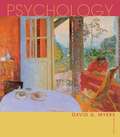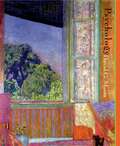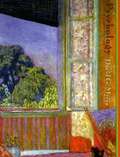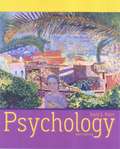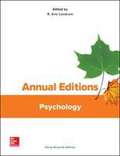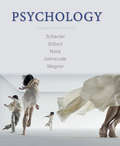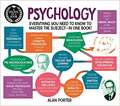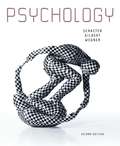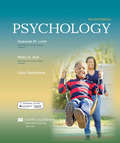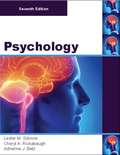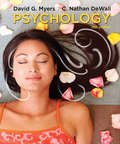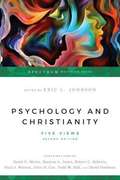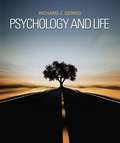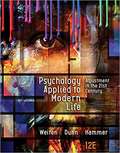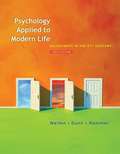- Table View
- List View
Psychology (2nd edition)
by Philip Zimbardo Ann L. WeberThis book represents a marriage of that scientific tradition with the immediacy and vitality of teaching what we know about the human condition. It is an enriched view of psychological knowledge that combines the basic, accumulated wisdom from scientific psychology with the contemporary views of human nature that emerge from the study of human diversity.
Psychology (3rd Edition)
by Saundra K. Ciccarelli J. Noland WhiteThe most learner-centered and assessment-driven text available With its engaging writing style and comprehensive coverage of key research, Psychology, 3/e, awakens students' curiosity and energizes their desire to learn more. This brief version draws readers into an ongoing dialogue about psychology, allowing them to fully grasp the subject. The authors establish clear learning objectives tied to the most recent APA-recommended undergraduate learning outcomes. MyPsychLab is an integral part of the Ciccarelli/White program. Engaging activities plus assessments provide a teaching and learning system that helps students master psychological concepts more readily. With MyPsychLab, students can watch videos on research and applications, participate in virtual classic experiments, and develop critical thinking skills through writing. Psychology, 3/e, is available in a new DSM-5 Updated Edition. To learn more, click here. This title is available in a variety of formats - digital and print. Pearson offers its titles on the devices students love through Pearson's MyLab products, CourseSmart, Amazon, and more.
Psychology (3rd edition)
by David G. MyersSwitching among several differing perspectives, this introductory textbook describes what scientific research has learned about the biology underlying human behavior and mental processes, changes during the life cycle, states of consciousness, learning and memory, intelligence, emotion, personality, and psychological disorders. The seventh edition adds a new section on motivation in the workplace, and a psychology timeline inside the hardcover. Annotation ©2004 Book News, Inc., Portland, OR (booknews.com)
Psychology (4th edition)
by Saul KassinThis book provides learning objectives for each chapter that help students organize key concepts of psychology.
Psychology (5th Edition)
by David G. MyersSwitching among several differing perspectives, this introductory textbook describes what scientific research has learned about the biology underlying human behavior and mental processes, changes during the life cycle, states of consciousness, learning and memory, intelligence, emotion, personality, and psychological disorders.
Psychology (7th Edition)
by David G. MyersThis new edition continues the story of psychology with added research and enhanced content from the most dynamic areas of the field--cognition, gender and diversity studies, neuroscience and more, while at the same time using the most effective teaching approaches and learning tools.
Psychology (8th edition)
by David G. MyersSwitching among several differing perspectives, this introductory textbook describes what scientific research has learned about the biology underlying human behavior and mental processes, changes during the life cycle, states of consciousness, learning and memory, intelligence, emotion, personality, and psychological disorders. The seventh edition adds a new section on motivation in the workplace, and a psychology timeline inside the hardcover. Annotation ©2004 Book News, Inc., Portland, OR (booknews.com)
Psychology (9th edition)
by David G. MyersSwitching among several differing perspectives, this introductory textbook describes what scientific research has learned about the biology underlying human behavior and mental processes, changes during the life cycle, states of consciousness, learning and memory, intelligence, emotion, personality, and psychological disorders. Annotation ©2004 Book News, Inc., Portland, OR (booknews.com)
Psychology (AP Edition)
by Philip G. Zimbardo Robert L. Johnson Ann L. Weber Craig W. GruberPsychology AP* Edition has been specifically designed to prepare you for the AP* Exam,with a close eye on content coverage and accuracy.
Psychology (Annual Editions)
by R. Eric LandrumThe Annual Editions series is designed to provide convenient, inexpensive access to a wide range of current articles from some of the most respected magazines, newspapers, and journals published today. Annual Editions are updated on a regular basis through a continuous monitoring of over 300 periodical sources. The articles selected are authored by prominent scholars, researchers, and commentators writing for a general audience. <p><p> Each Annual Editions volume has a number of features designed to make them especially valuable for classroom use: an annotated Table of Contents, a Topic Guide, an annotated listing of supporting websites, Learning Outcomes and a brief overview for each unit, and Critical Thinking questions at the end of each article. Go to the McGraw-Hill Create™ Annual Editions Article Collection at www.mcgrawhillcreate.com/annualeditions to browse the entire collection. Select individual Annual Editions articles to enhance your course, or access and select the entire Landrum: Annual Editions: Psychology, 47/e ExpressBook for an easy, pre-built teaching resource.
Psychology (Canadian Edition)
by Daniel M. Wegner Daniel L. Schacter Daniel T. Gilbert Matthew K. Nock Ingrid JohnsrudeThis widely used, enthusiastically received textbook is the work of one of the most accomplished author teams in introductory psychology, each a distinguished educator and researcher, and three of them (Schacter, Gilbert, and Wegner) authors of bestselling books for general readers. Together, they offer an approachable, engagingly written survey of the field's main ideas, filled with unusual stories, memorable examples, and lots of humor to captivate all kinds of students. And for this version, coauthor Ingrid Johnsrude from the University of Western Ontario again integrates a wealth of research and examples from Canada, giving Canadian students and instructors an introductory psychology textbook that is truly their own. Again carried by the authors' exceptional communication and teaching skills, the new edition has been retooled for the classroom chapter by chapter. Sections in each chapter now have specific Learning Outcomes in place, to emphasize "big picture" concepts and guide student learning. There is also new boxed feature called A World of Difference highlighting important research on diversity and individual differences, plus new Data Visualization Activities in LaunchPad, to help students build quantitative reasoning skills.
Psychology (Degree in a Book Series)
by Alan PorterThis book provides the reader with an overview of the different areas of psychology that are covered on a typical psychology degree course. Each chapter gives a general overview of the topic and introduces important concepts and research methods. In a series of boxes, important studies, individuals or methods are explored in greater depth. This will allow the reader to get a sense of the general ‘lie of the land’ and also a sense of the style of research carried out in different areas. At the end of the book, there is a section on further reading that provides a short, chapter-by-chapter, bibliography of books suitable for the general reader and textbooks targeted at psychology students.
Psychology (Ninth Edition, In Modules)
by David G. MyersThis ninth edition of Psychology, Ninth Edition in Modules is so much improved over the previous work. Changes include: * some 1300 new research citations representing the most exciting and important new discoveries in our field, * organizational changes based on changes in the field (for example, the heavily revised Consciousness unit, which now follows The Biology of Mind unit and is titled Consciousness and the Two-Track Mind to reflect the dual processing and cognitive neuroscience themes), * fine-tuned writing with countless small and large improvements in the way concepts are presented, supported by the input and creative ideas of hundreds of contributing instructors and students, and from my longtime editors, * a sharp new art program and new pedagogy that teaches more effectively, * continually improving coverage of cultural and gender diversity issues, and * 44 fewer pages.
Psychology (Second Edition)
by Daniel M. Wegner Daniel L. Schacter Daniel T. GilbertThoroughly revised and updated, the second edition of this popular introductory psychology textbook introduces effective new teaching techniques as well as a range of new topics. Clear and engaging, the book provides a fundamental insight into how the mind works.
Psychology (Second Edition)
by Deborah M. Licht Misty G. HullThoroughly revised with input and insight from many of the hundreds of adopters of the groundbreaking first edition, Scientific American: Psychology continues to set a new standard for the introduction to psychology. Deborah Licht and Misty Hull continue to combine their years of research and teaching insights with the journalistic skill of science writer Coco Ballantyne. Together, they have created an introductory psychology resource that combines print and digital components into a seamless learning experience. The project draws on written profiles and video interviews of 27 real people to help students better understand, remember, and relate to psychology’s basic ideas. Beautifully designed, the printed text is filled with high-interest examples and features, including full-page infographics that help students understand and retain key concepts. Online, additional author-created resources, including scaffolded activities and adaptive quizzes, provide a seamless learning experience for students and a reliable assessment mechanism for instructors and programs. This innovative collaboration between Worth Publishers and Scientific American reflects a commitment to engaging and educating all students, including those who sometimes seem difficult to engage—in the contemporary style of the world’s most respected science magazine.
Psychology (Seventh Edition)
by Lester M. Sdorow Cheryl A. Rickabaugh Adrienne J. Betz<p>If you have not adopted this book in the past, we believe that you will find that your students will be eager to read it and to learn from it. You will find that the book achieves interest and readability while also accomplishing the following goals: <p> <li>Portraying psychology as a science <li>Demonstrating the superiority of science over common sense <li>Showing that psychological research occurs in a sociocultural context <li>Illustrating the relevance of psychology to everyday life <li>Encouraging critical thinking in all aspects of life, particularly in regard to the media <li>Placing psychology in its intellectual, historical, biographical, and sociocultural contexts</li> </p>
Psychology (Tenth Edition)
by Carol Tavris Carole WadeThis text emphasizes the importance of critical thinking and the integration of culture and gender in the science of psychology and focuses on the development of critical thinking skills crucial to students' success in college and in later life.
Psychology (Twelfth Edition)
by David G. Myers C. Nathan DewallDavid Myers' new partnership with coauthor C. Nathan DeWall matches two dedicated educators and scholars, each passionate about teaching psychological science through writing and interactive media. <P><P>With this new edition of the #1 bestselling Psychology, Myers and DeWall take full advantage of what an integrated text/media learning combination can do. New features move students from reading the chapter to actively learning online: How Would You Know puts students in the role of scientific researcher and includes tutorials on key research design principles; Assess Your Strengths self-tests help students learn a little more about themselves, and include tips about nurturing key strengths. <P><P>These and other innovations rest on the same foundations that have always distinguished a new David Myers edition--exhaustive updating (hundreds of new citations), captivating writing, and the merging of rigorous science with a broad human perspective that engages both the mind and heart. This edition of Psychology is accompanied by its own dedicated version of Worth Publishers' breakthrough online course space, featuring a fully integrated e-Book, LearningCurve adaptive quizzing, a rich collection of student media resources, and easy setup, assessment, and course management options for instructors. <P>What's in the LaunchPad
Psychology And Christianity: Five Views (Second Edition) (Christian Association For Psychological Studies Books)
by David G. Myers Eric L. Johnson Robert C. Roberts Stanton L. Jones David A. Powlison P. J. Watson John H. Coe Todd W. HallHow are Christians to understand and undertake the discipline of psychology? This question has been of keen interest (and sometimes concern) to Christians because of the importance we place on a correct understanding of human nature. Psychology can sometimes seem disconnected from, if not antithetical to, Christian perspectives on life. How are we to understand our Christian beliefs about persons in relation to secular psychological beliefs? This revised edition of a widely appreciated text now presents five models for understanding the relationship between psychology and Christianity. All the essays and responses have been reworked and updated with some new contributors including the addition of a new perspective, the transformative view from John Coe and Todd Hall (Biola University).
Psychology And Life
by Richard J. GerrigPsychology and Life, 20th edition provides the perfect balance of science and accessibility so that students can understand research and its application to daily life. Richarg Gerrig combines classic and cutting-edge research studies with an engaging and student friendly writing style.
Psychology Applied To Work
by Paul Muchinsky Satoris HowesThe 12th edition of Psychology Applied to Work presents the story of I/O psychology as told through the most recent research, summarized in a focused and easy-to-comprehend manner. Five special features appearing throughout the book highlight the impact of I/O psychology on key contemporary issues and are designed to enhance student engagement in the field.
Psychology Applied to Modern Life: Adjustment in the 21st Century
by Wayne Weiten Dana S. Dunn Elizabeth Yost Hammer Margaret LloydFilled with comprehensive, balanced coverage of classic and contemporary research, relevant examples, and engaging applications, this text shows you how psychology helps you understand yourself and the complex social world around you. It also uses psychological principles to illuminate the variety of opportunities you have in your life and your future career.<P><P> While professors cite this bestselling book for its academic credibility and the authors' ability to stay current with 'hot topics,' students say it's one text they just don't want to stop reading. The text and associated workbook are highly readable, engaging, and visually appealing, providing you with a wealth of material you can put to use every day. Also available: the MindTap online learning experience, featuring an eBook, activities that engage you in thinking about common misconceptions about psychology, animations that introduce key concepts, cool apps (including a text-to-speech reader), and more.
Psychology Applied to Modern Life: Adjustment in the 21st Century (10th Edition)
by Wayne Weiten Dana S. Dunn Elizabeth Yost HammerFilled with comprehensive, balanced coverage of classic and contemporary research, relevant examples, and engaging applications, this book shows you how psychology helps you understand yourself and the world--and uses psychological principles to illuminate the variety of opportunities you have in your life and your future career.
